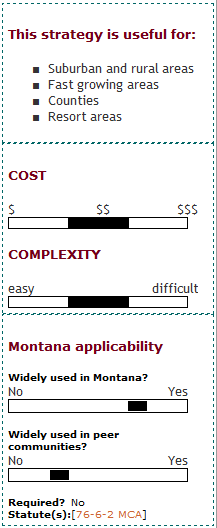

What is a Rural Land Conservation Easement?
An easement is an interest in land owned by another that entitles its holder to a specific limited use. Conservation easements are one of America's most commonly applied rural land preservation strategies. A landowner donates or sells easements that entitle a government agency, land trust, or other conservation organization to limit or prohibit development of the land in question. The land is still owned by the individual, but she or he cannot develop the property beyond the established limits, regardless of its zoning. Easements can be made in perpetuity, meaning that the easement is maintained even when the land is sold, so that subsequent owners abide by the development restrictions established by the holder.
Who can implement it?
Authorized under the Montana Open Space Land and Voluntary Conservation Easement Act (Title 76 Chapter 6 Part 2 MCA), landowners can voluntarily restrict development on a given parcel of their land through a negotiated agreement with a land trust, a conservation organization, or a government agency.
Landowners can sell their easement to the agency for cash, or they can donate it in exchange for substantial reductions in estate and Federal income taxes. Easements can be made in perpetuity and incumbent upon future landowners, or they can be temporary (a minimum of 15 years).
What are the keys to success and potential pitfalls?
Adequate Staff Resources: Rural land conservation programs require staff capable of managing the financial transactions and day-to-day stewardship of the preserved lands. Staff and resources are also needed to develop educational materials and encourage landowners to participate in the program. In many cases, local governments rely upon nonprofit agency staff to perform these functions.
Ongoing Funding: Public and private agencies use a broad range of funding sources to purchase conservation easements. Some localities allocate general government funds to an easement program. Local and state agencies can also support conservation easement programs with designated portions of funding streams such as impact fees or lottery revenues. Private nonprofit organizations often raise funds from community members and foundations, supplemented by public or private grants.
Where has this strategy been applied?
Examples in Montana
- The Montana Association of Land Trusts is a group of 12 separate nonprofit land trust organizations working on private land conservation and voluntary conservation agreements throughout Montana. The Association is comprised of these 12 private, nonprofit members:
- Prickly Pear Land Trust, Helena
- Gallatin Valley Land Trust, Bozeman
- The Trust for Public Land, Bozeman
- Flathead Land Trust, Kalispell
- Montana Land Reliance, Helena
- Five Valleys Land Trust, Missoula
- Bitter Root Land Trust, Hamilton
- The Conservation Fund, Missoula
- Rocky Mountain Elk Foundation, Missoula
- The Vital Ground Foundation, Missoula
- The Nature Conservancy of Montana, Helena
- Kaniksu Land Trust - Mt. Ascension Ridge Land Acquisition
The Mt. Ascension Ridge provides one of the most beautiful backdrops of any city in the US and is home to a 72-mile trail system. Much of the land on the ridge is private and could be shut off to public access at any time. Prickly Pear Land Trust (PPLT) has acquired over 80 acres of open space on the ridge, partly through the generosity of landowners and coordination with the Montana Fish and Wildlife Conservation Trust. These acquisitions to the land trust will help ensure connectivity of the trail system and keep the scenic view available to the public.
Examples outside of Montana
- Great Outdoor Colorado Trust Fund: The Great Outdoor Colorado Trust Fund has preserved more than 350,000 acres of land through conservation easements. Fifty percent of the revenue generated by the state lottery is dedicated to the conservation easement program.
- Biking on the Railroad: The Hiawatha Trail is a very popular 15-mile bike trail on an abandoned railroad bed that winds its way across the Bitterroot Mountains between Montana and Idaho and is regarded as one of the most scenic rides in the west. In 2007, the Forest Service secured funding for the acquisition of an additional 12 miles of the route, and the Five Valleys Land Trust (FVLT) agreed to help facilitate the purchase of the remaining parcels. FVLT signed a purchase agreement with the landowner and joined with the Forest Service to obtain the funding necessary to complete the purchase of the last 108 acres along the route.
How can I get started?
Many private landowners already participate in rural land preservation efforts, particularly conservation easement programs. A number of land trusts exist in Montana to handle the purchase or donation of conservation easements for rural preservation. Local governments can simply serve as a conduit for these well-established programs by educating themselves on the plethora of land banks that already exist in the state.
A first step is to research the existing land trusts in the state to better understand the priorities and missions of each organization. The community can then direct a private landowner to the appropriate entity should an opportunity for preservation arise.
